CUMIN IN THE VALLEY
TEXT: JENNY GUSTAFSSON
PHOTOS: JENNY GUSTAFSSON
RESEARCH: YARA WARD, ANGELA SAADE
EDITS: NISREEN KAJ
Making kammoun with Abu Shujaa and Um Shujaa
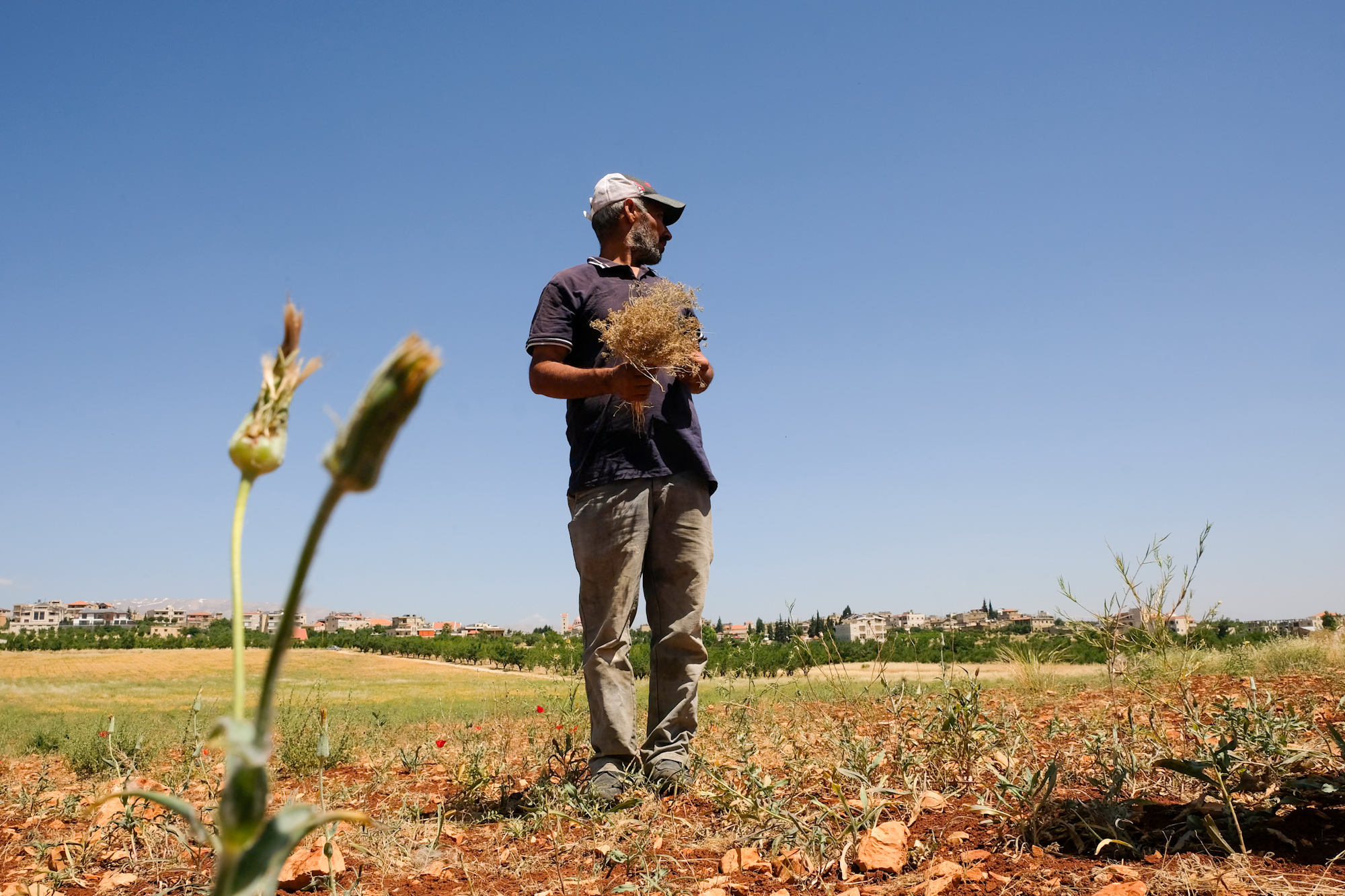
Mohammad el Ali, known as Abu Shujaa, in the fields where he grows cumin
The piece of land stretching towards the mountains of Syria looks harsh at first. It is dry and flat, shifting in color from pale green and yellow to terracotta. Wearing soft sneakers, Abu Shujaa, whose real name is Mohammad el Ali, walks across the field.
He stops now and then to pick up plants growing in the red soil. Soon, he has collected a small bouquet in his hands. The plant, which is dry and brittle, is cumin, a flowering member of the Apiaceae family (the same as carrot, parsnip, fennel, and herbs like dill, parsley, and cilantro). It grows happily under the warm sun.
“Cumin likes dry and hot weather, just like we have here in the Bekaa,” Abu Shujaa says.
He continues walking across the field. There are not many plants left; a few days ago, he harvested everything together with a group of agricultural workers. Now, he is just collecting plants that were left behind.
Cumin, primarily used as a spice, is popular in both Lebanon and Syria. It is used a lot in cooking: sometimes, as in the southern Lebanese dish kammouneh, it plays the lead role. It is also a popular remedy in local traditional medicine.
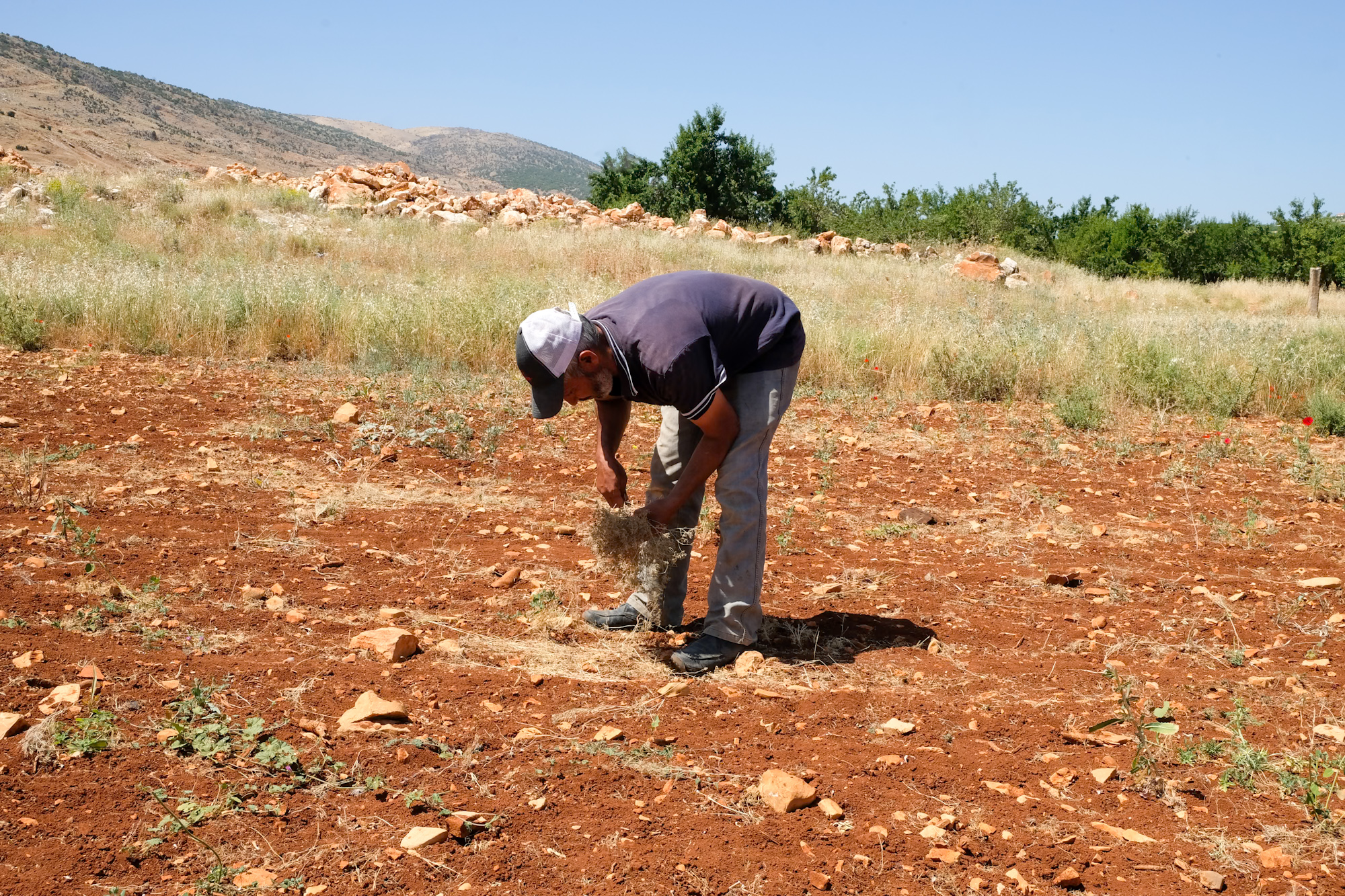
“Cumin is my favorite spice. I enjoy planting and harvesting it. And this is a good place to plant cumin,” Abu Shujaa says.
He continues walking through the field, stepping between stones and thistles growing in the soil. There is not much work today; he is merely passing by to see that all is fine in the land.
“We were 20 people harvesting here the other day. Cumin must be harvested by hand; it doesn’t grow tall, so you cannot use machines to harvest it,” he says.
The cumin plantation is located near the rural towns of Raait and Deir el Ghazal, in the eastern part of the Bekaa Valley, right where the mountains touch the plains. Abu Shujaa himself is from the countryside near Homs in Syria, but has lived here in the Bekaa since the war in his home country began. His wife is Lebanese and works in agriculture as well.
“I come from a great farming region near the Asi River. My whole family is all about agriculture. As a kid and teenager, I would spend all my time outdoors and in the fields,” Abu Shujaa says.
This is how he got his nickname shujaa, which means “brave” in Arabic, he explains. He started working in the fields at a young age, and people found this strong and brave.
Unlike many others from rural Syria, Abu Shujaa never worked in Lebanon during his youth. It was only when the war started that he left for Lebanon, the home country of his wife.
“When the war came to our region, many people left within a month or two. It became too dangerous to be in the fields. And if you tried to stay neutral, you would find yourself in trouble. I didn’t want to be involved, so we had nothing to do but to leave,” he says.
Abu Shujaa holds an empty chickpea shell. This year, most of his chickpea harvest was lost due to a fungal disease.
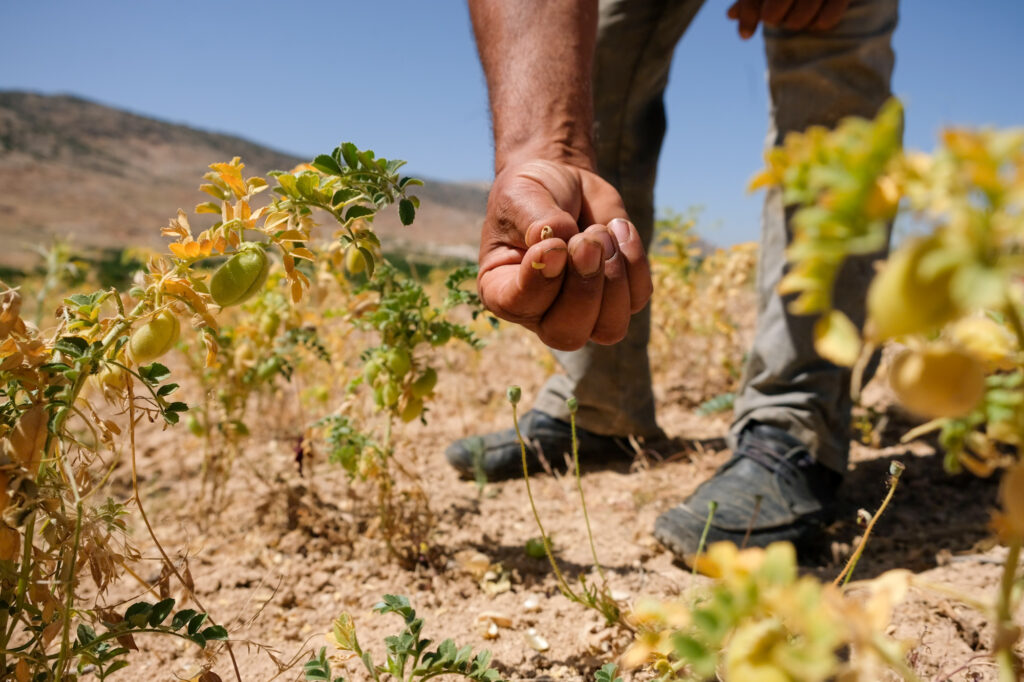
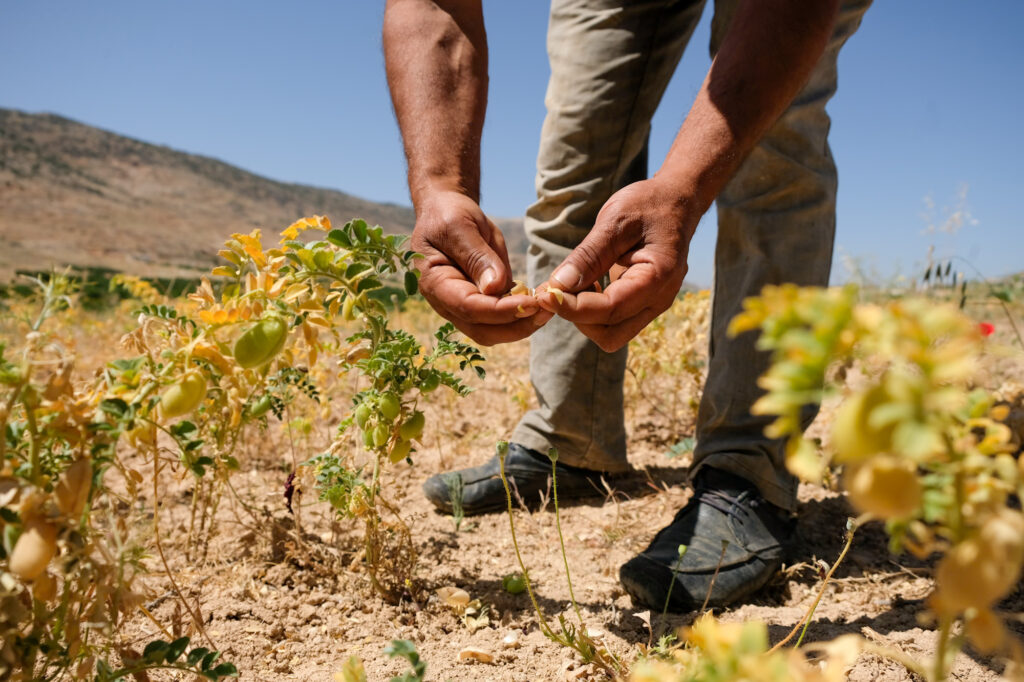

At first, Abu Shujaa worked in fields owned by other people. He would water and take care of the plants, harvest, and do other kinds of work.
“When you first arrive at a new place, you don’t know people, so you start like this,” he says.
Then, he got to know about Buzuruna Juzuruna, a farm working with organic and sustainable agriculture, offering trainings and providing small pieces of land.
“They told me, ‘We have this land and don’t want to leave it. How about you take care of it and we give support?’” Abu Shujaa says.
In Lebanon, a small landowning minority holds most agricultural land. One percent of farmers control one fourth of the land, and the top 10 percent hold 61 percent of land across the country. This reflects global inequality patterns. Even though small farms make up the majority worldwide, ownership of agricultural land remains in the hands of a minority. Some 16 percent control 88 percent of farmland globally.
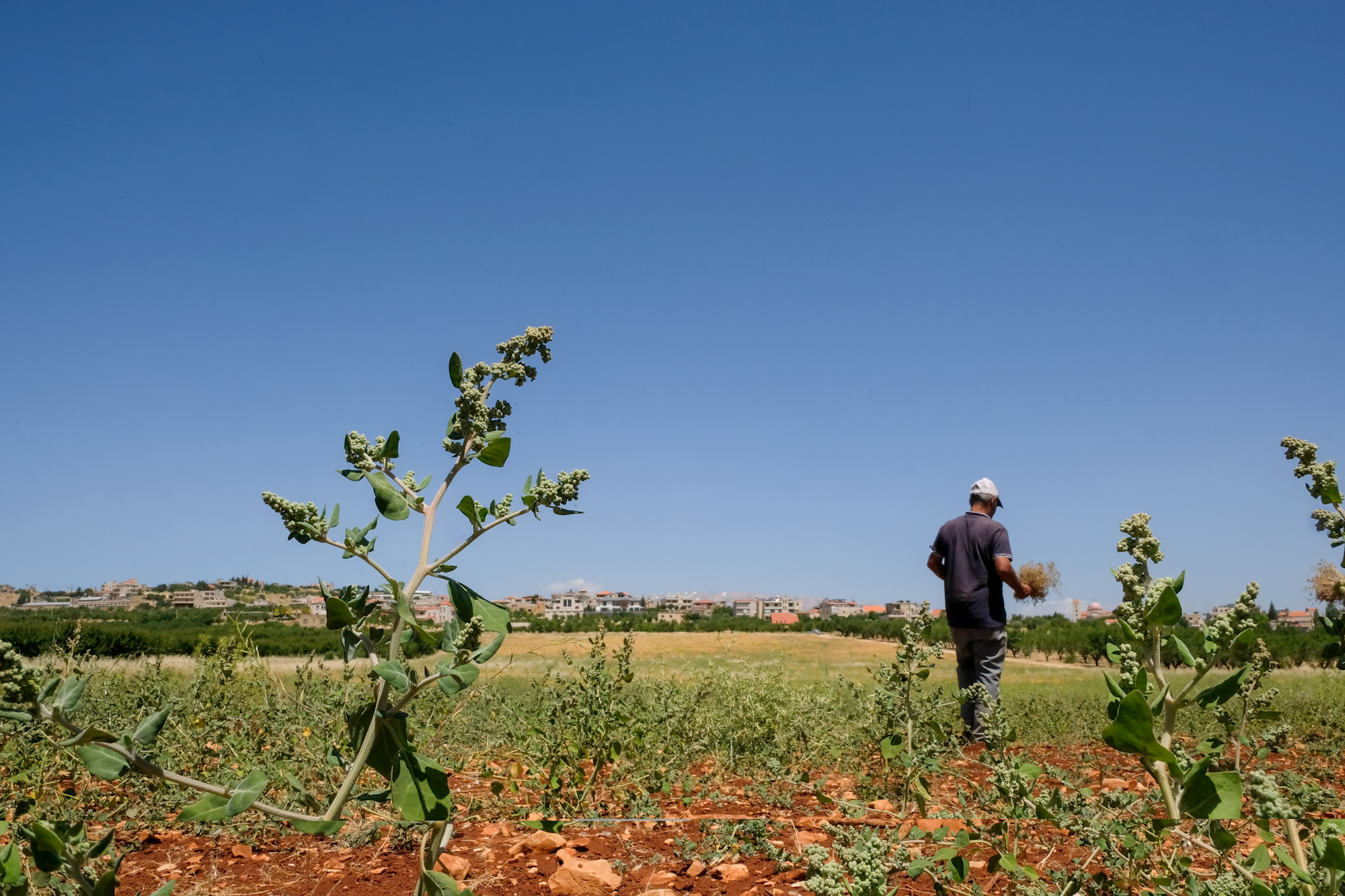
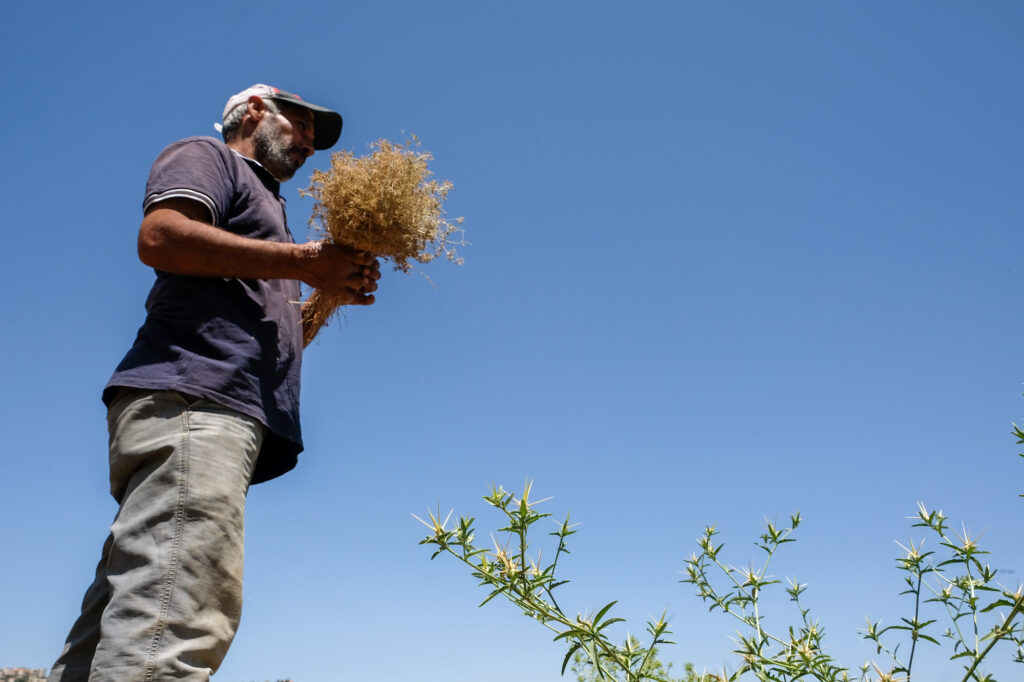

In Lebanon, land ownership was skewed long before it emerged as a modern country. By the late 1800s, at the end of the Ottoman era, a handful of families controlled large swaths of land. At the same time, rural lands made up the greater part of the empire as a whole. Some 60 percent of its inhabitants lived in the countryside, and revenues from farmland were considered the empire’s greatest single resource.
Legal codifications of land from this era remain in place in Lebanon today. The Ottomans categorized land according to ownership status and productivity, dividing it into categories like mulk (privately owned), mawat (unused), matrouk (abandoned), and waqf (religious endowment). Another category still valid in Lebanon today is miri or amiriya land. These lands are a kind of state-owned property where people from the public retain the right to cultivate and transfer it from generation to generation (in contrast to some religious legislation, this right applies equally to men and women).
During the Ottoman era, miri lands accounted for the majority of all arable land in today’s Lebanon (as well as in Syria and Palestine), except in Mount Lebanon. They were historically designated as agricultural domains rather than sites for building, and were often combined and redistributed in a kind of periodic rotation.
In contrast, mulk, or private property, was mainly restricted to gardens such as vineyards and orchards.
Miri land also has a “right of disposal,” meaning that people who use it retain that right unless they abandon the land for a period of five consecutive years, after which it may be taken over by someone else. This system contributes to agricultural lands being used and not left neglected or subject to speculation.
Today, there are 31,907 plots registered in the name of the state in Lebanon, according to mapping done by Public Works. Eighty percent of this land is in Akkar and the Bekaa, and Baalbek alone has more than one-third of state farmland. Public Works calls these lands a “national wealth” directly linked to “livelihoods across Lebanon.” In recent years, however, several political proposals have been put forward to either merge miri and private lands or sell state-owned land, something that would undoubtedly increase inequality in agriculture
“When I started working on this land with Buzuruna Juzuruna, they gave me access to a tractor and a car. I couldn’t have that otherwise,” Abu Shujaa says.
He picks up another plant from the ground. It is chickpeas, growing low on stalks with pale green leaves. But when he opens a shell with his fingers, the pea inside is small and dry. The plants were affected by a fungal disease, and much of the harvest was lost this year.
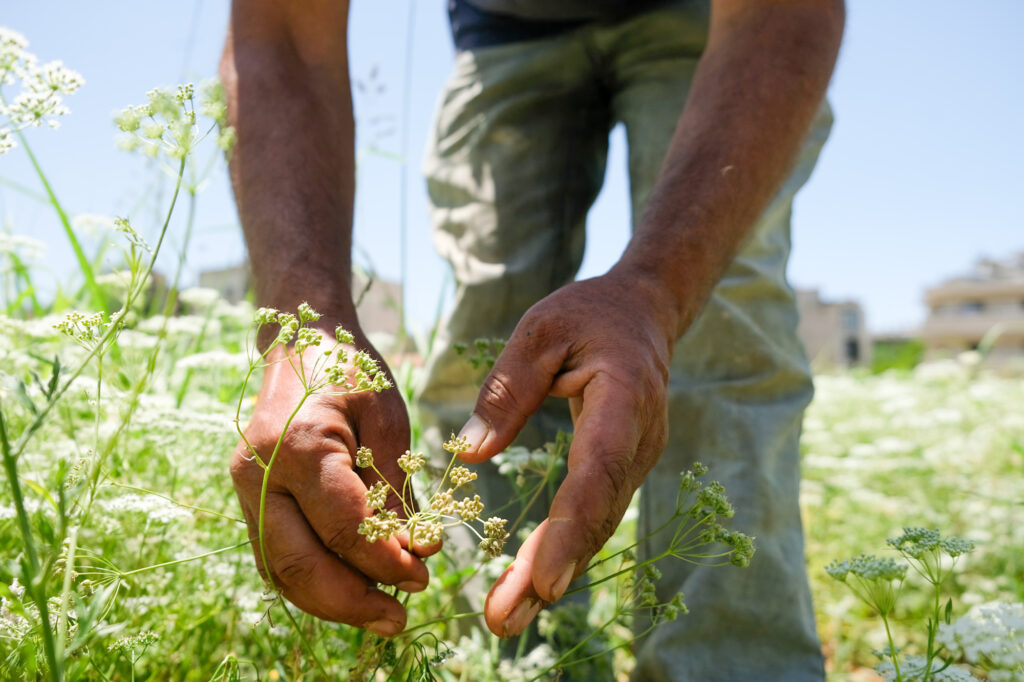
Abu Shujaa grows different crops, including anise.

His cumin, on the other hand, thrived. The crop is popular in this part of the Bekaa, where the soil is dry and the summers hot. Cumin actually grows better in soil that is nutrient poor, according to food writer Marryam Reshii, because it “makes the plant work hard to extract every particle of flavor from the earth.”
Across the world, cumin can be found growing in desert-like conditions. India, where the spice is known as jeera, from the Sanskrit word for digestion, grows around 70 percent of all cumin in the world. Perhaps the best cumin of all comes from the deserts in the state of Rajasthan (which is also said to produce the best henna in the world).
The exact origins of cumin are not known, but most evidence points to somewhere in the eastern Mediterranean, Nile Valley, or West Africa. Like all spices, it traveled across the world through trade and other routes, spreading from the Mediterranean to the Indian subcontinent and the Americas.
It appears in one of the first written records in the world: a recipe recorded in the ancient cuneiform script originating in today’s Iraq. These tablets, dating back to circa 1700 BCE, list cumin alongside ingredients like onion and garlic. The word cumin is actually the only English word, it is said, that can be traced directly back to Sumerian, the world’s first written language, in which the plant was called gamun (close to Arabic’s “kammun”).
Other historical recipes also include cumin. Dishes served at the famous feast thrown by the ninth-century Assyrian king Ashurnasirpal II to celebrate the construction of his new capital, Nimrud, had lots of cumin. The ancient Egyptians coated their bread with cumin before baking – and offer it as a gift; archaeologists have found cumin seeds in several excavations.
Kitab al Tabikh, written in Baghdad in the tenth century and known as the earliest Medieval cookbook, noted cumin’s various medicinal properties, including its ability to “facilitate digestion and induce burping.” The early Egyptians knew about its therapeutic properties too and used it to treat upset stomachs and coughing. Indian Ayurvedic medicine continues to rely on cumin, mainly as a digestive aid.
“We use cumin for many things: stomachache, anxiousness. If you can’t sleep at night, you can drink hot cumin and you will sleep well,” Abu Shujaa says.
A few weeks have passed, and he is sitting at home in Saadnayel, where he lives with his wife and children, half an hour away from the cumin plantation. Their home is somewhere between a house and a tent, constructed with simple wooden beams and tarpaulin sheets. It is cool inside, despite the strong midday sun.
His wife, Nahla el Abid, who goes by Um Shujaa as a nod to her husband, comes into the room. She has spent the morning taking care of molokhia, a green leafy plant popular in Syrian and Lebanese cuisines. The floor in one of their rooms is now covered with molokhia leaves, left to dry for a couple of days.

The cumin and chickpea fields stretch towards the mountains separating Lebanon and Syria
There is a slight smell of cumin coming from the kitchen: earlier, Um Shujaa cooked potatoes with cumin
“We also use it when we make kibbeh, and it is very tasty when you add cumin to loubieh bi banadoura,” she says.
“You can add it to anything, and the dish will taste good. Like a small amount to roasted chicken,” Abu Shujaa says.
The two of them sit on mattresses placed along the walls of the living area. There is room for many guests. Their youngest children, Khaled and Malak, are playing on the floor.
After a while, their oldest son, Youssef, appears at the door to say goodbye. He is going to work at a chips factory in another part of the Bekaa.

“It is not difficult to store cumin, just make sure it doesn’t get moist. The strong smell keeps rats and snakes away.”
Um Shujaa goes to the kitchen. She is preparing “kammoun,” or simply cumin, which refers to a hot drink made with the spice. She makes it often, she says.
“We drink kammoun a lot. In winter, we always keep it on the stove in the afternoons. Even if you don’t plan to drink it immediately, it is nice to let the aroma fill the house,” she says.
“This is the old way of doing it. All families usually do this at home. My kids even come to me sometimes when they have pain somewhere and ask if they can go and make kammoun,” she says.
She takes out a metal pot, fills it with water, lights the gas flame on the stove, and sets the water to boil. From a glass jar, she scoops tablespoons of cumin seeds into the water. This is the cumin Abu Shujaa harvested from the land earlier.
“You think it’s a lot? No, no. You need this much!”
In the kitchen, she also keeps jars with mouneh, prepared during the summer to last over the winter months. There is a tray with bright orange and red saffron, something she tried to grow for the first time this year.
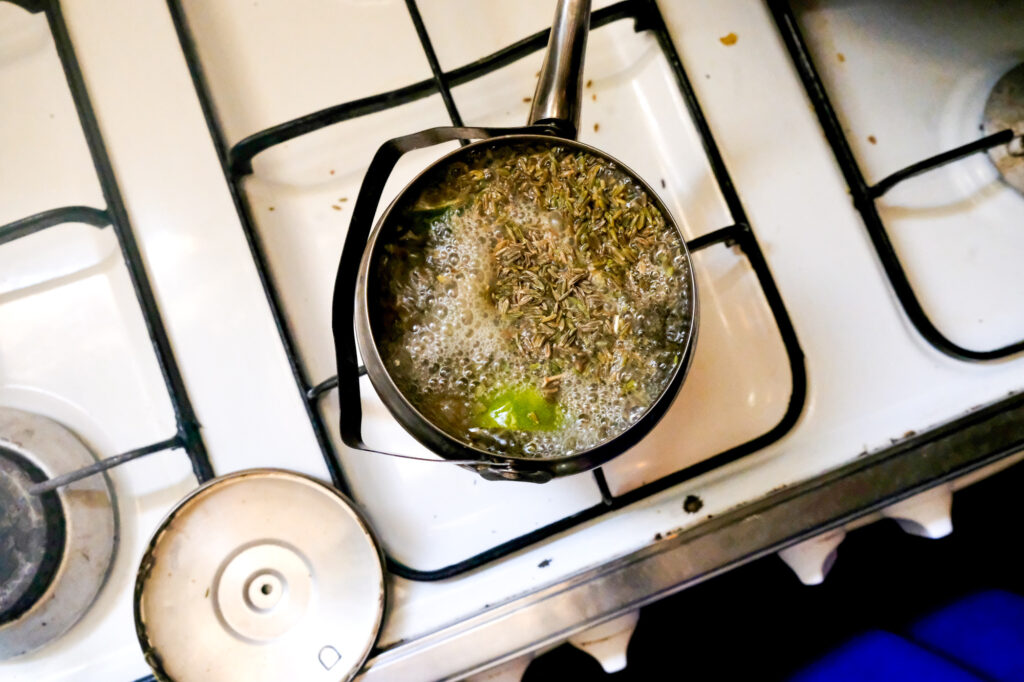
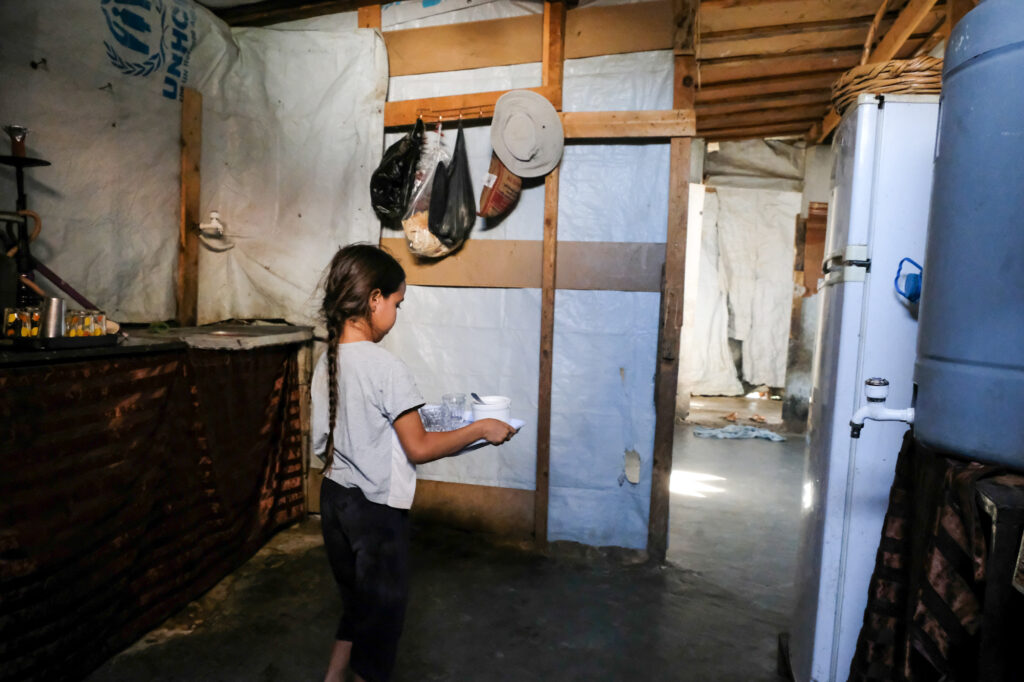
Kammoun can be had either salty or sweet, depending on your preference.
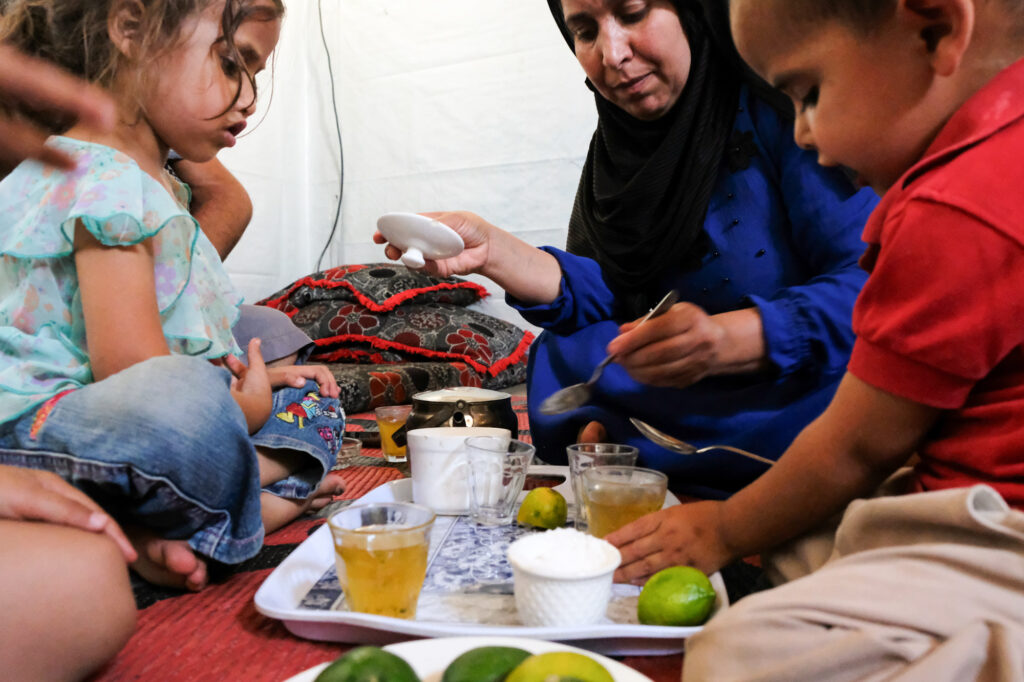
When the water has boiled for a couple of minutes, she turns off the flame and prepares a tray with small cups, lemons, and both salt and sugar (depending on preference). Fatima, her daughter, comes to get the tray from the kitchen.
In the living room, they all sit down around the hot kammoun. Um Shujaa starts serving everyone, asking if they want it sweet or salty. “Ana sukkar,” sugar for me, all the children say – except for Khaled, the youngest one. He thinks for a split second, then says that he wants salt.
“I’m usually the only one who drinks it with salt. That’s how we used to do it in my family when I was growing up,” Abu Shujaa says.
“I prefer it like that because salt doesn’t have the same harmful effects as sugar. And it reduces the bitterness a bit.”
They continue talking about food and farming, about their lives in rural Syria before the war.
“Our village near al Rastan is very quiet and peaceful. You don’t hear a sound at night. Everyone in the village is a farmer, that’s how life is,” Abu Shujaa says.
“It used to be so beautiful. It really was a paradise,” Um Shujaa says.
One of Abu Shujaa’s cousins stayed despite the war and is now managing their land. However, agriculture is nothing like it used to be. People mainly grow for self-sustenance now, they say, as there is no money in selling vegetables and produce. And they have shifted to only rain-fed crops, since it is hard to secure electricity or fuel for water pumps.

Nahla el Abid, who uses the name Um Shujaa, came to her native Lebanon with her family when the war in Syria started
“My cousin helps us so that the land doesn’t get ruined. We told him to plant and harvest as he likes; just don’t leave the land neglected,” Abu Shujaa says.
Next year, in the field near Raait and Deir el Ghazal, he will not grow cumin. It does not yield well if you keep planting it in the same place year after year. He knows from experience, he says.

Abu Shujaa has lived and worked in Lebanon since the war began in his region, rural Homs, in Syria
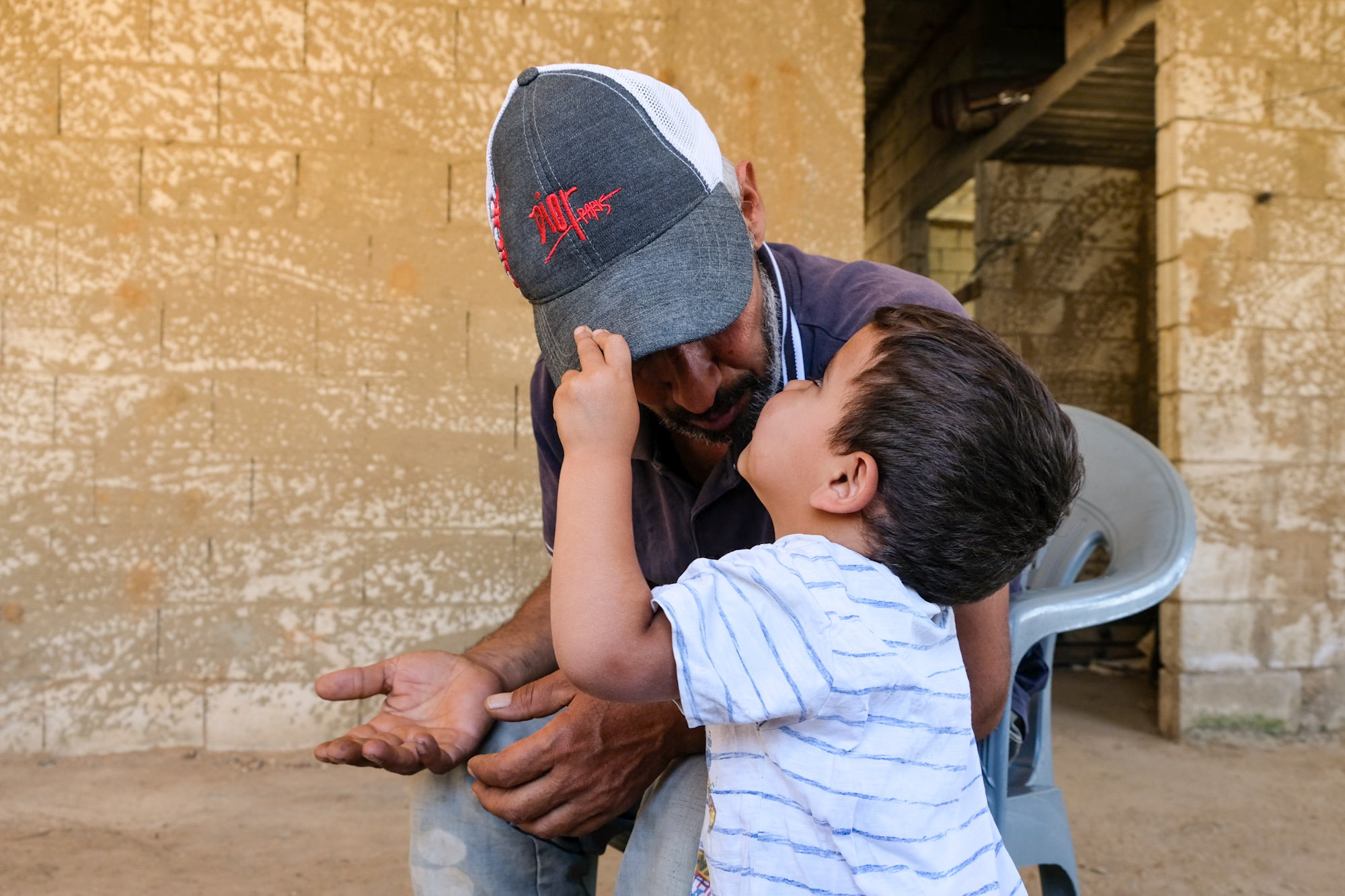
“You need to rotate and grow other crops, at least every four years, in case you want to plant again in the same spot.”
He is thinking about planting lentils next, a kind of small lentil that can yield some profit (larger lentils, he says, are currently sold for such low prices that farmers end up losing money).
Or he might try chickpeas again, but plant them a bit differently this time.
“This is why I like agriculture. There’s always one thing that replaces the other. Had I planted only chickpeas this year and not cumin, everything would’ve been lost,” he says.
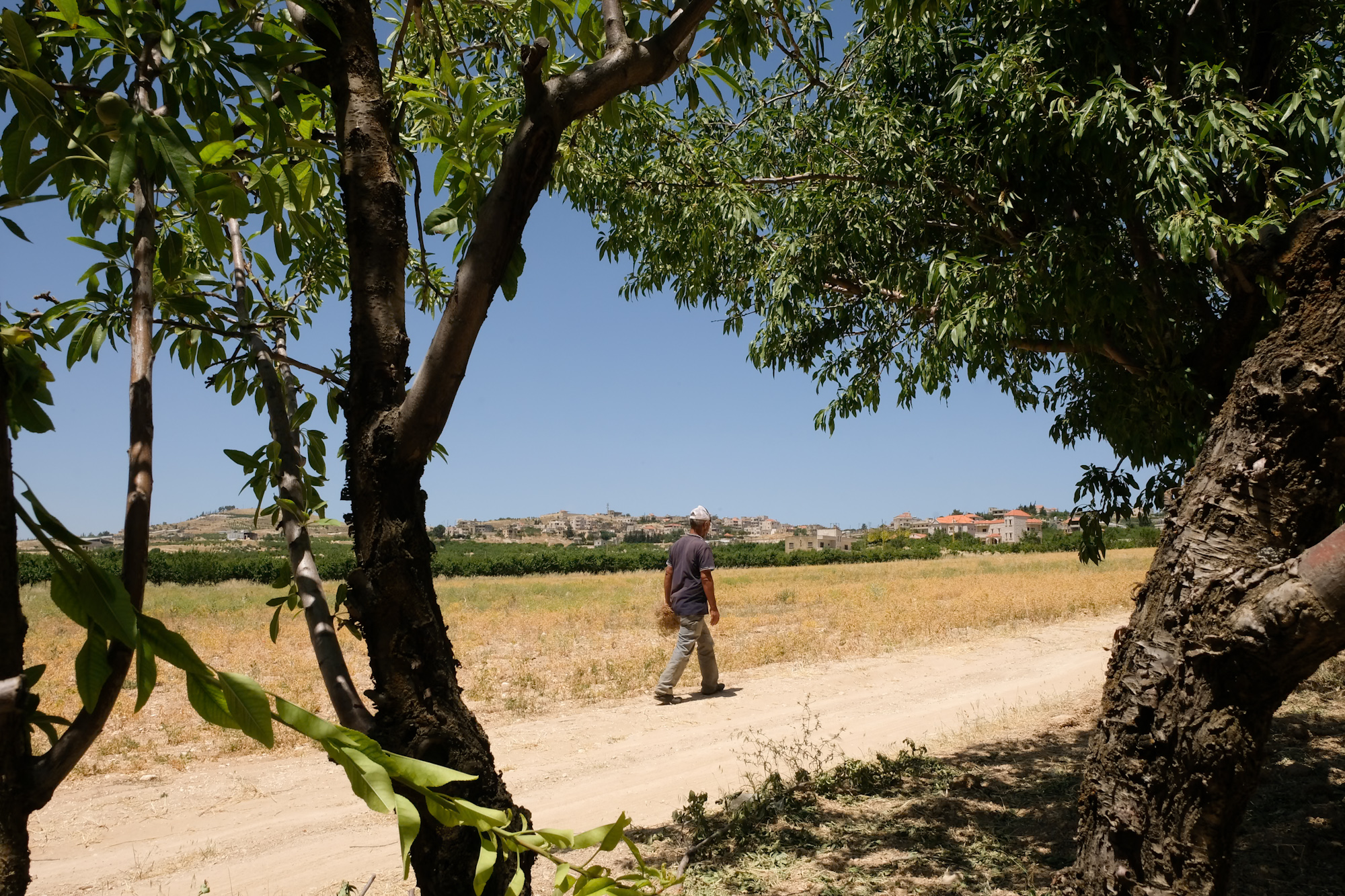
EPILOGUE
A couple of weeks later, at the end of September, Israel launched heavy bombardments across (mainly) southern Lebanon, Beirut, and the Bekaa Valley. Abu Shujaa and Um Shujaa’s everyday life changed dramatically. On the second day of intensified attacks, Um Shujaa’s relatives arrived from Nabatieh in the south. They now house 20 people in their small one-family home. Their days are now unpredictable, as the areas surrounding Saadnayel continue to be bombed. One day, while Um Shujaa and other women worked in a field, a nearby area, Karak, was attacked. They saw the sky suddenly light up, she says, and ran back home in fear. Their cumin and chickpea land is now out of reach, as the road to get there is dangerous, and nearby areas have been hit. Like other farmers, the family has not been able to sell much produce, as trade and wholesale have been disrupted. Abu Shujaa also has very little work: apart from managing the land, he normally works with a man growing roses not far from Saadnayel.
“My sister left all her olive trees without harvesting them this year. They came to us without money, without anything. I always open my heart to other people. But I hope they can return to their homes,” Um Shujaa says.
“Where can we be in safety now? How can we take care of our kids, how can we manage things? We fear just leaving our homes now.”
